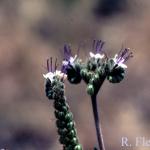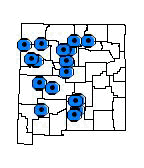Phacelia neomexicana (New Mexico Scorpion-Weed)
PHACELIA GLANDULOSA NUTTALL VAR. NEOMEXICANA (THURBER EX TORREY) A. GRAY
Annual, 8-68 cm tall; stems erect, sparsely branched, setose and with stipitate glandular hairs; leaves pinnate, 3-8.5 cm long, 1-4.5 cm wide, strigose, stipitate-glandular, petioles to 1.5 cm long, margins irregularly incised; inflorescence terminal on the main stem and lateral branches, more stipitate-glandular than leaves, individual inflorescence branches with 1-3 cymes to 10 cm long in fruit; flowers with pedicels to 0.5 mm long, congested; sepals linear to narrowly oblanceolate, averaging 2.7 mm in flower and 4.5 mm in fruit, setose and heavily stipitate glandular; corolla blue, campanulate, 4 mm long, 3-3.5 mm wide, lobes pubescent and erose; stamens exserted 1 mm; mature seeds 4, oblong, brown, 3.2-3.3 mm long, 1.1-1.5 mm wide, alveolate, ventral surfaces excavated on both sides of ridge. Flowers late July to middle October.
Closely related to Phacelia denticulata from which it can be distinguished by its exserted stamens and style, and smaller and more deeply excavated seeds. Closely related to Phacelia alba from which it can be distinguished by having a darker blue or purple corolla, stamens that are exerted only about 1 mm, and a style measuring 3-5 mm.
New Mexico, Bernalillo, Catron, Cibola, Lincoln, Los Alamos, McKinley, Otero, Rio Arriba, San Juan, San Miguel, Sandoval, Sierra, Socorro, and Torrance counties; Arizona, Apache County; Utah.
Canyons and mountain slopes in pine and oak woodlands; 2,100-2,750 m (6,800-9,000 ft).
Relatively widespread in distribution, but populations appear to be small and sporadic. Nevertheless, there are far too many populations over a large range for this to be a New Mexico rare plant.
The effects of forest fire on Phacelia neomexicana have not been studied.
Atwood, N.D. 1975. A revision of the Phacelia crenulatae group (Hydrophyllaceae) for North America. Great Basin Naturalist 35(2):127-190.
For distribution maps and more information, visit Natural Heritage New Mexico





